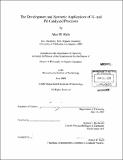| dc.contributor.advisor | Stephen L. Buchwald. | en_US |
| dc.contributor.author | Hyde, Alan M. (Alan Michael) | en_US |
| dc.contributor.other | Massachusetts Institute of Technology. Dept. of Chemistry. | en_US |
| dc.date.accessioned | 2009-11-06T16:28:58Z | |
| dc.date.available | 2009-11-06T16:28:58Z | |
| dc.date.copyright | 2009 | en_US |
| dc.date.issued | 2009 | en_US |
| dc.identifier.uri | http://hdl.handle.net/1721.1/49746 | |
| dc.description | Thesis (Ph. D.)--Massachusetts Institute of Technology, Dept. of Chemistry, 2009. | en_US |
| dc.description | Vita. | en_US |
| dc.description | Includes bibliographical references. | en_US |
| dc.description.abstract | Chapter 1. Ti-Catalyzed Asymmetric Reduction of Aromatic Heterocycles A method for the highly selective asymmetric reduction of quinoxalines and quinazolines was developed. This complements technologies developed by others for the asymmetric reduction of other aromatic heterocycles. This chemistry utilizes a Ti catalyst based on the C2-symmetricansa-metallocene scaffold. In these studies, we utilized a novel silane as a reducing reagent that showed superior properties in the reduction of difficult substrates. We then used this chemistry to prepare a variety of tetrahydroquinoxalines and tetrahydroquinazolines in up to >99% ee. Chapter 2. A Method for the Pd-Catalyzed y-Arylation of Ketones and its Application to a One-Pot Synthesis of Tricyclic Indolines The Pd-catalyzed ca-arylation of enolates is a rapidly growing area of chemistry due its usefulness in constructing key C-C bonds. After thorough optimization, we have identified a catalyst system for the regioselective y-arylation of ketone dienolates, allowing for a convenient preparation of quaternary y-aryl ca,-unsaturated ketones. A key finding was the influence of the supporting ligand on the observed regioselectivity. Bidentate ligands with a small bite angle such as dppe allow for exclusive arylation at the y-position. As a novel application of this chemistry, we also developed a one-pot domino reaction of 2-bromoanilines with P,y-unsaturated ketones for the preparation of indolines. Further, use of the chiral ligand DTBM-SegPhos allows for asymmetric induction with excellent levels of enantioselectivity. | en_US |
| dc.description.abstract | (cont.) Chapter 3. Synthesis of 5,5-Disubstituted Butenolides Based on a Pd-Catalyzed y-Arylation Strategy Given the utility and wide presence of butenolides in chemistry, and our recent foray into y-arylation chemistry, we sought to apply this chemistry to the preparation of y-aryl butenolides. Supporting ligands were identified that, when combined with a Pd source, catalyzed the site-specific y-arylation of butenolides with a wide variety of aryl halides. Progress was also made in the development of an asymmetric variant using chiral phosphine ligands. Preliminary screening results led us to prepare of a library of MOP-type ligands, which were tested with the use of high-throughput screening in a collaboration with Symyx. Chapter 4. Computational Studies on the Pd-Catalyzed Arylation of Amides and Enolates The rapid growth in the capability of computers and computational chemistry programs has been invaluable to the study of structure and mechanism in the field of catalysis. We have applied computational methods to study several catalytic reactions developed in the Buchwald lab: namely, the C- versus N-arylation of oxindoles, the N-arylation of amides with a newly-developed catalyst, and the regioselective y-arylation of dienolates. Beginning with oxindole arylation, we showed that the selectivity for C-arylation with a Pd/XPhos catalyst is governed by the relative barriers for reductive elimination and falls within the definition of a Curtin-Hammett situation while the N-arylation of oxindole with a Cu-based catalyst results from a large preference for binding of Cu to nitrogen. | en_US |
| dc.description.abstract | (cont.) In the second study, the arylation of acyclic secondary amides with a newly discovered catalyst system was studied and the important features of this ligand were identified. Our final study was devoted to providing a mechanistic rationale that explains the experimental observations of Pd-catalyzed y-arylation reactions. A novel mechanism for reductive elimination was identified and calculated to be the operative pathway. Chapter 5. Development of a Method for the Pd-Catalyzed Bromination of Aryl Triflates An efficient Pd catalyst was identified for the bromination of aryl triflates using high-throughput screening. A major obstacle to achieving full conversion was catalyst inhibition by the triflate salts formed over the course of the reaction. A solution to this problem was discovered, which involved the sequestration of these salts by the addition of a trialkylaluminum Lewis acid. This interaction was characterized by calorimetric studies, showing that triflate-trialkylaluminum binding is very strong. Further work is needed to fully develop this methodology and extend it to forming aryl chlorides. | en_US |
| dc.description.statementofresponsibility | by Alan M. Hyde. | en_US |
| dc.format.extent | 423 p. | en_US |
| dc.language.iso | eng | en_US |
| dc.publisher | Massachusetts Institute of Technology | en_US |
| dc.rights | M.I.T. theses are protected by
copyright. They may be viewed from this source for any purpose, but
reproduction or distribution in any format is prohibited without written
permission. See provided URL for inquiries about permission. | en_US |
| dc.rights.uri | http://dspace.mit.edu/handle/1721.1/7582 | en_US |
| dc.subject | Chemistry. | en_US |
| dc.title | The development and synthetic applications of Ti- and Pd-catalyzed processes | en_US |
| dc.type | Thesis | en_US |
| dc.description.degree | Ph.D. | en_US |
| dc.contributor.department | Massachusetts Institute of Technology. Department of Chemistry | |
| dc.identifier.oclc | 455437950 | en_US |
